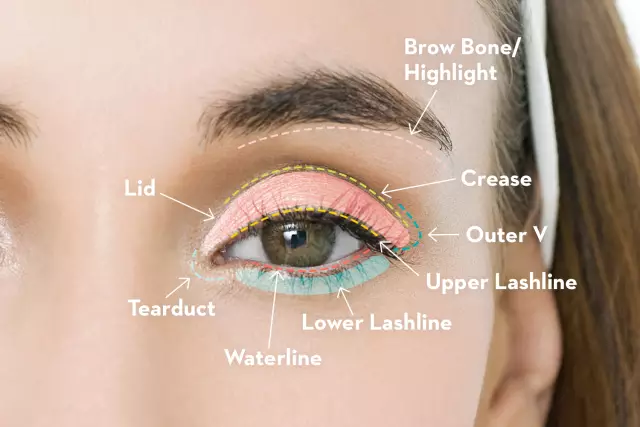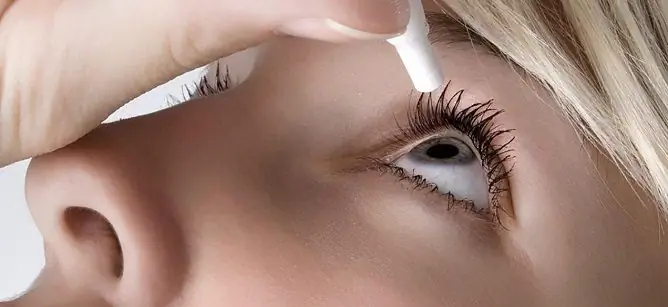- Author Rachel Wainwright [email protected].
- Public 2023-12-15 07:39.
- Last modified 2025-11-02 20:14.
Okumed
Okumed: instructions for use and reviews
- 1. Release form and composition
- 2. Pharmacological properties
- 3. Indications for use
- 4. Contraindications
- 5. Method of application and dosage
- 6. Side effects
- 7. Overdose
- 8. Special instructions
- 9. Application during pregnancy and lactation
- 10. Use in childhood
- 11. Drug interactions
- 12. Analogs
- 13. Terms and conditions of storage
- 14. Terms of dispensing from pharmacies
- 15. Reviews
- 16. Price in pharmacies
Latin name: Ocumed
ATX code: S01ED01
Active ingredient: timolol (Timolol)
Manufacturer: Sentiss Pharma Pvt. Ltd. (Sentiss Pharma Pvt. Ltd.) (India)
Description and photo update: 2019-08-10
Prices in pharmacies: from 28 rubles.
Buy

Okumed is an anti-glaucoma agent.
Release form and composition
The drug is produced in the form of eye drops: a clear, colorless solution (5 ml each in a dark glass bottle, closed with a rubber stopper, rolled in an aluminum cap, in a cardboard box 1 bottle complete with a sterile dropper in a plastic bag; 5 or 10 ml each in a plastic bottle - a dropper with a screw cap, in a cardboard box 1 dropper bottle and instructions for the use of Okumed).
1 ml of solution contains:
- active substance: timolol (in the form of maleate) - 2.5 or 5 mg;
- additional components: sodium dihydrogen phosphate, sodium hydrogen phosphate, benzalkonium chloride, water for injection.
Pharmacological properties
Pharmacodynamics
Timolol is a non-selective β-adrenergic receptor blocker that does not differ in internal sympathomimetic and membrane-stabilizing activity. When used topically, the active substance in the form of eye drops provides a decrease in both normal and increased intraocular pressure (IOP) as a result of a decrease in the production of intraocular fluid. The drug has no effect on accommodation and pupil size. The effect of timolol is manifested 20 minutes after the introduction of drops into the conjunctival cavity. The maximum decrease in IOP is recorded after 1-2 hours and persists for 24 hours.
Pharmacokinetics
When Okumed is used topically, the active substance quickly passes through the cornea. After instillation of drops in the aqueous humor of the anterior chamber of the eye, the maximum concentration (C max) of timolol is noted after 1-2 hours. Through absorption, the drug in a small amount enters the systemic circulation through the vessels of the conjunctiva, the nasal mucosa and the lacrimal duct. Excretion of timolol metabolites is produced mainly by the kidneys.
In newborns and young children, C max significantly exceeds that in the blood plasma of adults.
Indications for use
- open-angle glaucoma;
- ophthalmic hypertension (increased IOP);
- secondary glaucoma;
- congenital glaucoma (with insufficient effect of other therapeutic measures);
- angle-closure glaucoma, as an additional drug to lower IOP (in combination with miotics).
Contraindications
Absolute contraindications (including history data):
- cardiogenic shock;
- acute heart failure;
- atrioventricular block (AV block) of II and III degrees;
- sinus bradycardia;
- severe chronic heart failure (CHF) of III and IV functional classes, according to the NYHA (New York Heart Association) classification;
- allergic reactions with generalized skin rashes;
- bronchial asthma or other severe chronic obstructive airways disease;
- degenerative diseases of the cornea;
- atrophic rhinitis;
- neonatal period;
- hypersensitivity to any component of the drug.
Relative (use Okumed eye drops with caution):
- pulmonary emphysema, pulmonary insufficiency;
- severe cerebrovascular insufficiency;
- sinoatrial blockade;
- heart failure of I and II functional classes according to NYHA classification;
- arterial hypotension;
- hypoglycemia, diabetes mellitus;
- thyrotoxicosis;
- pheochromocytoma;
- Raynaud's syndrome;
- myasthenia gravis;
- combined treatment with other β-blockers;
- childhood.
Okumed, instructions for use: method and dosage
Okumed eye drops are intended for instillation into the conjunctival sac.
Adults, children and adolescents over 10 years of age are recommended to inject 1 drop of 0.25% solution 2 times a day. If the effect of therapy is insufficient, 1 drop of a 0.5% solution is administered at the same frequency of injections.
After normalization of IOP, instillations are carried out once a day, the maintenance dose is 1 drop of a 0.25% solution.
Children under 10 years of age are recommended to inject 1 drop of 0.25% solution 2 times a day. The course of treatment with Okumed is usually long. Temporary cancellation of therapy or correction of the dosage regimen may be carried out only as directed by the attending physician.
Side effects
- respiratory system: shortness of breath, rhinitis, bronchospasm, pulmonary insufficiency;
- organ of vision: lacrimation or decreased tearing, dry eyes, burning and itching in the eyes, hyperemia and irritation of the conjunctiva and / or skin of the eyelids, photophobia, corneal hypesthesia, corneal epithelium edema, diplopia, punctate superficial keratopathy, ptosis, short-term visual acuity, conjunctivitis, blepharitis, keratitis; when performing surgical treatment for glaucoma in the postoperative period, there is a risk of developing detachment of the choroid;
- nervous system: drowsiness, dizziness, headache, weakness, ringing in the ears, slowing down of the speed of psychomotor reaction, paresthesia, myasthenia gravis, depression, hallucinations;
- cardiovascular system: lowering blood pressure, chest pain, heart failure, bradyarrhythmia, bradycardia, AV block, collapse, transient cerebrovascular accident, cardiac arrest;
- immune system: urticaria, eczema;
- digestive system: nausea, diarrhea, vomiting;
- others: nosebleeds, alopecia, decreased potency.
Overdose
In case of an overdose of Okumed as a result of local absorption, systemic effects inherent in β-adrenergic receptor blockers may occur, such as nausea, vomiting, headache, dizziness, bronchospasm, arrhythmia, bradycardia.
In this condition, it is required to immediately rinse the eyes with water or 0.9% sodium chloride solution. If necessary, symptomatic treatment is performed.
special instructions
During therapy with Okumed, IOP measurements and corneal examinations should be carried out regularly.
With the development of side effects, you need to stop treatment with the drug and seek advice from a specialist.
Okumed is not recommended for patients wearing soft contact lenses, since the preservative included in the drops can be absorbed by these lenses and adversely affect the eye tissue.
Before the start of instillation, it is recommended to remove hard contact lenses, and put them on again only 15 minutes after its completion.
When switching to Okumed therapy, it may be necessary to correct refraction after the disappearance of the effects of miotic drugs that were previously used.
If the patient is to undergo a surgical operation using general anesthesia, the use of Okumed should be discontinued at least 48 hours before its start.
Influence on the ability to drive vehicles and complex mechanisms
Immediately after the instillation of Okumed, there is a possibility of a decrease in vision clarity and a slowdown in the speed of psychomotor reactions (these disorders are especially enhanced with the simultaneous use of the drug with ethanol), which can negatively affect the ability to drive vehicles and control complex mechanisms.
Application during pregnancy and lactation
It has been found that timolol crosses the placenta and is excreted in breast milk. The use of Okumed in pregnant women is possible only if the expected therapeutic effect for the mother outweighs the potential risk of adverse reactions in the fetus.
During the course of treatment, it is required to stop breastfeeding.
Pediatric use
During the neonatal period, the use of Okumed is contraindicated.
There is no sufficient experience in the use of the drug in children, as a result of this, Okumed therapy in patients of this age category is allowed only if the expected benefit from the treatment exceeds the possible threat of the development of undesirable phenomena.
Drug interactions
- eye drops containing epinephrine: pupil dilation may occur;
- other β-blockers for topical use: do not instill two β-blockers in the eyes at the same time;
- eye drops containing pilocarpine and epinephrine: the effect of timolol increases - the decrease in IOP increases;
- blockers of slow calcium channels, other β-blockers, reserpine: the threat of an increased decrease in blood pressure and a slowdown in heart rate increases;
- insulin, oral antidiabetic agents: the risk of hypoglycemia is aggravated;
- peripheral muscle relaxants: the effect of these drugs is enhanced, it is necessary to cancel the administration of timolol 48 hours before surgery with the use of general anesthesia.
Analogs
The analogues of Okumed are Timolol, Glautam, Arutimol, Timolol-long, Oftan Timogel, Oftan Timolol, Okumol, Rotima, Okupres-E, Timolol-AKOS, etc.
Terms and conditions of storage
Store out of the reach of children, protected from light penetration, at a temperature not exceeding 25 ° C, without freezing.
Shelf life is 2 years.
After the first opening of the bottle, eye drops should be used within 45 days.
Terms of dispensing from pharmacies
Dispensed by prescription.
Reviews about Okumed
For the most part, the reviews about Okumed are positive. Patients note the effectiveness of the drug in the treatment of ophthalmic hypertension and various forms of glaucoma. However, they emphasize that to achieve the desired result, long-term treatment is usually required, at least 6 months. Many people successfully use the drug to lower IOP before surgery.
At the same time, some patients complain about the lack of a positive effect after treatment with Okumed. The disadvantages of antiglaucoma drugs also include the development of side effects.
Price for Okumed in pharmacies
The price of Okumed, eye drops 0.5%, for a dropper bottle, depending on the volume, can be: 5 ml - 45-55 rubles, 10 ml - 60-70 rubles.
Okumed: prices in online pharmacies
|
Drug name Price Pharmacy |
|
Okumed 0.5% eye drops 5 ml 1 pc. 28 RUB Buy |
|
Okumed eye drops 0.5% 5ml RUB 55 Buy |
|
Okumed 0.5% eye drops 10 ml 1 pc. RUB 56 Buy |
|
Okumed eye drops 0.5% 10ml RUB 57 Buy |

Maria Kulkes Medical journalist About the author
Education: First Moscow State Medical University named after I. M. Sechenov, specialty "General Medicine".
Information about the drug is generalized, provided for informational purposes only and does not replace the official instructions. Self-medication is hazardous to health!






